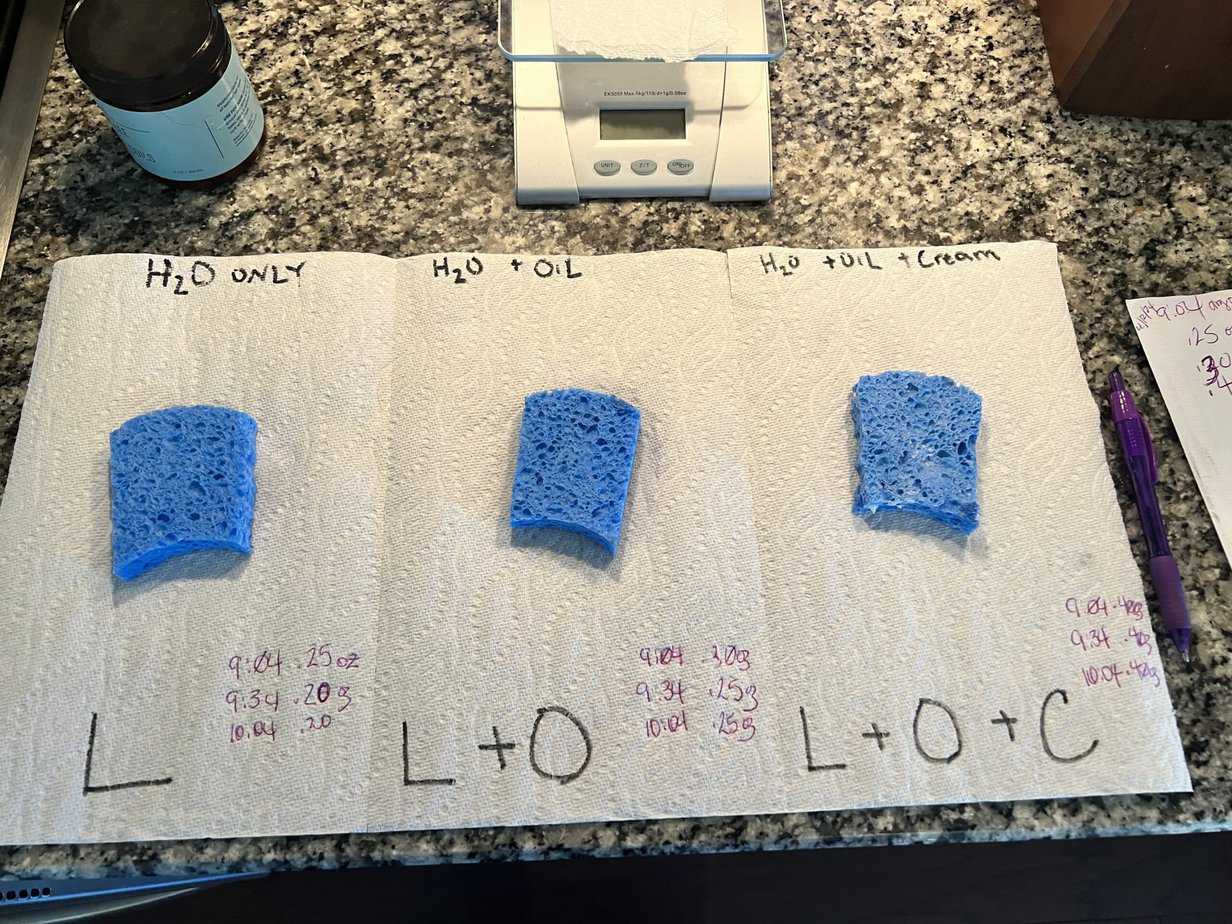
Moisturization is essential for natural hair - there's no doubt about it. Without it, your curls simply won't flourish.
While there are tons of tips and techniques for how to keep your girls hydrated, none are as widely accepted as the LOC method, a layering technique that can help you unlock the best version of your hair.
If you're new to the LOC method, you've got a lot to learn. In this article, we will introduce you to the LOC hair regimen and tell you exactly how to do it for maximum natural hair hydration.

Table of Contents
What Is the LOC Method?
The LOC method is a godsend for curly girls with dry, crispy strands. The acronym stands for Liquid, Oil, and Cream, each of which will be layered onto the hair to maximize moisture retention.
The LOC method was named by the founder of curly hair care brand Alikay Naturals, Rochelle Graham-Campbell. She learned about the method from a book called "Grow It" by Chicoro, which discussed hair growth in scientific terms.
The LOC method has been around for several years, and countless naturals swear by the technique. It has transformed many women's hair from a dry crunchy mess to hydrated, supple, pliable hair that better resists brittleness and damage.

Should You Try the LOC Method?
The LOC method was created for people with high porosity hair. High porosity hair has raised cuticles which make it difficult for the hair to hold onto moisture.
The LOC method is an excellent solution to this problem, given that it creates a barrier between the hair and the outside environment, encouraging moisture retention.
This is not to say that the LOC method is only for those with high porosity hair. It can be used on all hair types. One of the main benefits of the LOC method is that it can be tweaked to work for any hair type - more on that later on in this article.
Not sure what your hair porosity level is? You can try the hair porosity test, where you drop a strand of your clean hair into a cup of water.
If, after a few minutes, your hair floats on top of the water, your hair is considered low porosity. If your hair stays suspended under the water, your hair is deemed to be medium porosity. If it sinks to the bottom of the cup of water, you have high porosity hair.
Note: This porosity test is pseudoscience, but it's a fun way to get a general idea, even it's not 100% accurate. Read this article to learn more about hair porosity.
The LOC Method Acronym

It's probably safe to say that you know the basics of the LOC method by now. But let's dive a little bit deeper into the acronym.
In the list below, we will get into all three parts of the LOC method in detail:
- Liquid - The "L" in the LOC method stands for liquid and prompts you to infuse your hair with moisture. Some believe that they can use water for the "L" step, but according to the creator of the LOC method, the liquid portion of the LOC method stands for water-based leave-in. Still, many people use water in a spray bottle for this step without issue.
- Oil - The "O" in the LOC method stands for oil and is the first chance you get to seal in the moisture from the previous step. Naturally, this step in the LOC method calls for sealing oils, like coconut oil, sweet almond oil, or argan oil. Not just any oil will do, as super heavy oils can ruin your hairstyle by weighing your hair down.
- Cream - The "C" in the LOC method stands for cream. And by creams, we mean natural butters, styling creams, or even cream moisturizers. The cream essentially finishes off the process by sealing in the hair oil and liquid. After this step, you're ready to style your hair as you usually would. According to the creator of the LOC method, this step is optional but necessary for anyone with super dry hair.
How to Do the Loc Method
Now that you know what the LOC method is, it's time to get down to business and learn exactly how to do it. Some people tend to get confused by the steps, so we will walk you through the process without leaving anything out.
Gather Your Materials
Before you get started, we recommend picking up the following materials:
- Shampoo
- Conditioner
- Water-Based Leave-in
- Sealing Oil of your choice
- Cream styler or moisturizer
- Wide-tooth comb
- Alligator clips or elastics (optional)
- A towel (optional)
Prep Your Hair for the LOC Method

Before you reach for your liquid, oil, or cream, your hair needs to be sufficiently prepped. Let's get into the hair prep steps below.
Wash Your Hair
Doing the LOC method on unwashed hair diminishes its benefits. This is because unwashed hair may have buildup or dirt that inhibits the products' ability to do their work. So, it's crucial to wash your hair before doing the LOC method.
To start, you should wash your hair with a gentle, natural shampoo. It's almost always best to avoid sulfate shampoos and opt instead for sulfate-free varieties.
When you wash your hair, make sure that you focus the shampoo on the roots instead of the ends of your hair, as this allows your hair to better retain moisture at the ends, which are the oldest parts of your hair.
Rinse thoroughly after shampooing your hair. You don't want the shampoo to stay on your strands and dry them out over time.
Condition and Detangle
After shampooing your hair, condition with your regular rinse-out conditioner. The type of conditioner you should use will depend on your regimen and hair goals, but most naturals can get by with a natural moisturizing conditioner.
When applying the conditioner to your hair, focus on the ends of your hair rather than the roots. The ends of your hair are the oldest and need the most TLC.
While the conditioner is still on your hair, detangle your hair with a wide-toothed comb. The slipperiness of the conditioner will make detangling your hair a breeze. And the more knot-free your hair is, the easier it will be to complete the LOC method steps.
Dry Your Hair
Drying your hair is the final preparatory step you should take before doing the LOC method. The easiest way to dry your hair is to simply allow it to air dry. However, you can towel dry your hair with a microfiber towel if you're short on time.

Start Layering
With your hair sufficiently prepped, you're ready to get started layering your hair products according to the LOC method. Here are the steps you need to take to get the best results:
- Part your hair into at least 4 sections with or without a comb. Twist and clip each section of hair up with alligator clips. If you don't have clips, you can use elastics or twist your hair. This not only makes the hair easier to work with but also helps with product distribution. If you skip this step, you may have trouble getting the products on your hair evenly.
- Secure each of the sections with an alligator clip, elastic, or twist to keep them separate.
- Choose one of the four sections and release the hair. This will be the first section you work on.
Apply Your Leave-in
- Spray the section with your water-based leave-in conditioner. Make sure that every strand in the section is completely coated in the leave-in. This will be your first layer of moisture.
- Use your fingers or a wide-tooth comb to gently distribute the leave-in throughout the section.
- Once you've saturated the section with the leave-in and combed it through, twist the section around and use your alligator clip or elastic to secure it up and out of the way.
- Apply the leave-in conditioner to all of the other sections and then resecure them.
Apply Your Oil
- Now, release one of the sections and apply some oil to it. You don't want to over-apply your oil, or else your hair will become a weighed down, greasy mess. Just a few drops of oil per section should be sufficient in most cases. But you should use your judgment - if your hair is extremely dry, feel free to use a few more drops of oil.
- Gently run your fingers through your curls to distribute the oil evenly.
- Repeat the previous two steps on all of the sections.
Apply Your Cream
- To complete the LOC method, apply your styling cream. For this step, you can use as much or as little styling cream as you need to achieve the look that you desire.
- Repeat the previous step on all of the sections.
- Release all of the sections and proceed to style your hair as normal.
The Dos and Don'ts of the LOC Method

The LOC method is pretty straightforward, but it's not uncommon to run into issues. To ensure that you have a no-fuss experience as you try out the LOC method, we'd like to fill you in on some of the dos and don'ts associated with the LOC method:
Dos
- Do choose your products carefully. Since everyone's hair is different, you may need a different liquid, oil, and cream than someone else. For instance, if you have wavy hair, you should reach for super lightweight products that won't make your hair limp and stiff.
- Do test out multiple product combinations. If you try the LOC method and don't get the results you want, it could be that you did not use the right products for your hair. In that case, feel free to give the LOC method another try with different products. Using the wrong liquid, oil, or cream can negatively affect your hair.
- Do pay attention to your hair before doing the loc method, at every step of the LOC method, and afterward. If you don't pay attention to your hair at all times, it'll be difficult to know whether the LOC method is working for you.
- Do start the LOC method with dry or damp hair. Some do it on wet hair, but this can be problematic. If your hair is already drenched before you start the LOC method, it may not be able to accept the moisture you'll be adding.
- Check the ingredients in the products you'll be using for the LOC method. You may be surprised by what you find. Some of the ingredients you should definitely avoid are drying alcohols and sulfates, which could dry your hair out, inhibiting the effectiveness of the LOC method.
Don'ts
- Don't over-apply the products. This is especially important for those who have super loose curls or fine hair. Over-applying your products is a sure-fire way of weighing your hair down and eliminating its volume.
- Don't be stingy with the products. While you should never over-apply your products during the LOC method, you should always take the time to make sure that all of your strands have been coated in the product. If you don't, you may have some dry spots of your hair that don't behave and stick up more than the rest.
- Don't use a leave-in that doesn't have water as the first ingredient. Some manufacturers call their leave-ins water-based even when water isn't one of the first five ingredients. So, you'll have to check on this yourself.
How Often to Do The LOC Method
One topic that has been widely debated is how often to do the LOC method. The answer is that it depends on the quality of your hair and your hair routine.
If you regularly wash your hair once a week and your hair is in relatively good condition, you can do the LOC method once a week.
If your hair is severely damaged or dry, you may need to do the LOC method more often than once a week - think once every few days.
If your hair feels dry immediately after doing the LOC method, perhaps you're not using the correct products or applying enough of each product. In that case, switch things up. Eventually, you'll find the winning combination that your hair will love.

Pros and Cons of the LOC Method
The LOC method is one of the best ways to moisturize curly natural hair. But, just like everything else, it comes with both pros and cons.
Knowing these pros and cons can help you determine whether this moisturization method is for you. In the section, we will examine the good, the bad, and the ugly:
Pros
- The LOC method is relatively easy to follow and can be adapted to suit every hair type.
- Many credit the LOC method with transforming their hair from dry and brittle to soft and supple.
Cons
- It's hard to find concrete, matter-of-fact information about how to do the LOC method correctly. Therefore, it is hard to specify precisely how much of each product to apply, making the technique a bit harder for some to perfect.
- The LOC method requires several products and some experimentation in some cases. This can quickly get expensive.

Make the LOC Method Method Work for You
Some ladies within the natural hair community have tried the LOC method without success and then blamed the technique. This is a bit unfair given that we choose the products we’ll use during the process.
A lot of times, the reason why the LOC method doesn't work is that the products weren't suitable for your hair. To help prevent a disastrous situation, here are some tips to help you choose the right products:
- Straight/wavy hair - Type 1 and type 2 hair don't usually get dry due to the fact that the scalp oils are easily able to lubricate the strands. However, after chemical processing or excessive heat, these hair types may indeed need the LOC method. If you are using the LOC method on straight or wavy hair, ensure that the products you choose are super lightweight. If you choose heavy products, your hair will be weighed down and look greasy.
- Curly/Kinky hair - Type 3 and type 4 hair have a distinct curl pattern (either coils or kinks) and is prone to dryness. This is because the scalp's oils aren't able to adequately moisturize the length of the strands due to the twists and turns that make up curls. Hair types 3 and 4 rarely lack volume, so you could use heavier products for the LOC method if you'd like. It may even be necessary depending on your hair porosity.
- High porosity hair has difficulty holding onto moisture, so it needs heavier products and oils to stay moisturized. Use heavier natural oils like castor oil and olive oil, and medium to heavy curl creams to help your hair retain moisture.
- Low porosity hair can be challenging to moisturize, given that its cuticles lay flat. So, if you want to use the LOC method for low porosity hair, opt for light oils like jojoba oil and argan oil, and lightweight creams.
- LOC vs LCO Method for Natural Hair
- How Often Should You Moisturize Your Hair for Curls
- Is It Bad To Wet Natural Hair Everyday?
- How to Moisturize Low Porosity Hair in Protective Styles
In your pursuit of healthy hair, we hope you have found this article helpful and that it has encouraged you to try using the LOC method. We wish you the best as you work to keep your hair healthy and hydrated. For a slightly different approach to LOC, read our article on the LCO Method.




